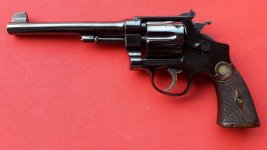There are some inconsistencies to balance. J frames in general have heavier triggers due to the geometry in the action. While this can be addressed to some extent, it can be a problem for some shooters. Given your description, I can see this applying to your student. Rimfires also need heavier triggers as a general rule to have the ability to consistently light off the primers in RF rounds. This can be a potential problem.
That said, to a great extent I think a .22 is a good starter gun, and less likely to generate a recoil impulse that is bothersome. The .22 Magnum is nothing to sneer at, but often a lot louder than one would expect, which can contribute to flinching and other signs of recoil sensitivity. (Good hearing protection, with plugs and GOOD muffs combined, will help.) There is a short barrel God Dot round that as I recall is designed for handgun length barrels and has more care in production to deal with the problem of rimfire primer quality control. It is designed for defensive use in a .22 magnum revolver. If either .22 is the best your candidate can do in terms of control, self-confidence, proficiency, ability to practice, etc, then that's how it goes. Good hits with that as a result of knowing anatomy and development of good mindset and physical skills beats the heck out of a wish and strong language.
Bigger heavier guns with smaller rounds will have less recoil impulse transferred to the shooter. At the extreme, a 5" N frame .357 with .38 wadcutters would be a good example. From your description of the candidate, it would be too far to the extreme. Small hands and the like implies to me a real possibility of not enough strength for that platform, too. A loser. For the reasons I describe above, a J frame might also be too far to an extreme, in the other direction. That may not be correct.
Compromise, once you get some time to start with the shooter and have her (?) develop some skill and comfort: A K frame. In all honesty, the M14 with wadcutters is really easy to shoot. It is far easier to get a decent trigger weight in a K frame than a J. It may still be too heavy. A 3" k frame is likely to be a decent compromise, especially if carry is (at least potentially) in the future. I prefer the adjustable signs on Smiths (and most firearms, especially revolvers). Not because they are adjustable, but because they are easier to see in a hurry. They are potentially less snag resistant, but that's a tradeoff that has to be considered. Most of the attributes I would consider from your description might require a custom revolver to achieve; probably not a great idea.
Among factory models that might work well, once you have some baseline knowledge about the shooter's comfort and the shooter is making progress: a 2" M15 with the smallest grips (likely rubber) you can find. While the 4" is certainly going to be easier to shoot in some ways (the 4" barrel is easier to use in terms of the sights), it may still be too heavy, and will have a square butt frame. The 2" will have the same actual mechanical accuracy potential (ergonomics will be different, but ...), a decent trigger, visible sights, and a round butt. Load it with quality .38 wadcutters (which are actually a decent defensive load if the bullet is square enough) (I prefer Black Hills; the boutique makers are likely to load it heavier). Recoil will be relatively low. Standard velocity .38 SWC are a decent load too (I have a bunch and use them in my 4" M66 for most uses), but may be too stout for the person you describe. They are a better reload than the WC, as WC are harder to get into the cylinder in a hurry. If the sights are still sub-optimal, consider replacing the front with an XS Big Dot tritium, and widening the slot in the rear sight to match.
One guy's thoughts, and worth what you paid for them.

